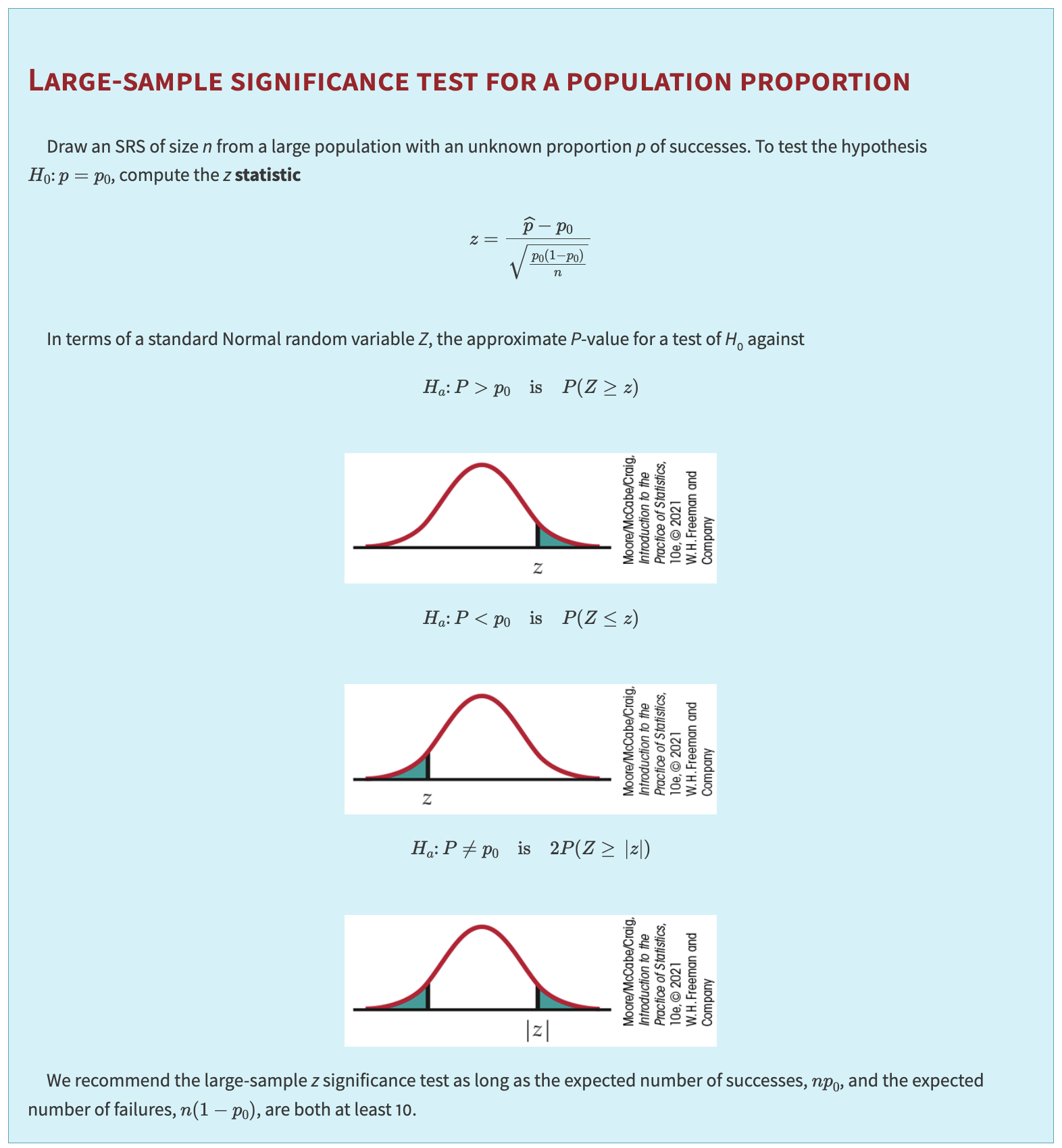15. Chapter 8: Inference for a Single Proportion#
We can view Inference for a Sample Proportion as a Special Case of Inference for a Sample Mean. Below is a step-by-step comparison showing how inference for a sample proportion can be viewed as a special case of inference for a sample mean, along with the corresponding assumptions. We will walk through estimation, confidence intervals, hypothesis testing, and sample size determination.
15.1. Why Is a Sample Proportion a Special Case of a Sample Mean?#
Sample Proportion \(\hat{p}\) arises naturally when each observation \(X_i\) is a Bernoulli random variable (1 = “success” or 0 = “failure”) with probability \(p\).
Mathematically, if \(X_i \sim \mathrm{Bernoulli}(p)\), then
Notice that \(\hat{p}\) is simply the sample mean of \(\{\,X_i\}\). Hence, the usual formulas for a mean (variance, confidence intervals, test statistics) have analogues for proportions, substituting the Bernoulli variance \(p(1-p)\).
15.2. Parameter of Interest#
15.2.1. General Case (Sample Mean)#
Parameter of interest: Population mean \(\mu\).
Each observation \(Y_i\) has mean \(\mu\) and variance \(\sigma^2\).
The sample mean is \(\bar{Y} = \frac{1}{n}\sum_{i=1}^n Y_i\).
15.2.2. Special Case (Sample Proportion)#
Parameter of interest: True success probability \(p\).
Observations \(X_i \in \{0,1\}\) with \(E[X_i] = p\) and \(\mathrm{Var}(X_i) = p(1-p)\).
The sample proportion is \(\hat{p} = \frac{1}{n}\sum_{i=1}^n X_i\).
15.3. Point Estimation#
15.3.1. Estimator#
Sample Mean: \(\bar{Y}\) is the unbiased estimator of \(\mu\).
Sample Proportion: \(\hat{p}\) is the unbiased estimator of \(p\) (equivalently, \(\hat{p} = \bar{X}\) when \(X_i \in \{0,1\}\)).
15.3.2. Variance of the Estimator#
Sample Mean: \(\mathrm{Var}(\bar{Y}) = \sigma^2 / n\).
Sample Proportion: \(\mathrm{Var}(\hat{p}) = \frac{p(1-p)}{n}\).
15.4. Confidence Intervals (CIs)#
15.4.1. Large-Sample (Z-Based) CI for a Mean#
15.4.1.1. General Case#
If \(\sigma\) is known (or \(n\) large, so we approximate \(\sigma\) by \(s\)), a z-interval for \(\mu\) is:
15.4.1.2. Special Case (Proportion)#
For large \(n\), we use the normal approximation for \(\hat{p}\):
This is exactly the same form as the mean’s z-interval, substituting \(p(1-p)\) by \(\hat{p}(1-\hat{p})\). This CI is sometimes called the Wald interval for a proportion.
15.4.2. Small-Sample (T-Based) CI for a Mean#
15.4.2.1. General Case#
For smaller \(n\), we often use the t-distribution:
where \(s\) is the sample standard deviation of \(Y_i\), assuming the population is (approximately) normal.
15.4.2.2. Proportions#
Typically, we do not use a t-interval for proportions. Instead, for small \(n\), one uses:
Exact binomial confidence intervals, or
Approximate intervals like the Wilson or Agresti-Coull intervals.
For large \(n\), the normal (Wald) approximation is common.
15.4.3. Assumptions for Valid CI#
Mean (General):
Random/independent sample.
For Z-based intervals: either \(\sigma\) known or large \(n\) so that \(\bar{Y}\) is approximately normal by the CLT.
For T-based intervals: data from (approximately) a normal population or \(n\) large enough that T is robust.
Proportion (Bernoulli):
Random/independent Bernoulli trials.
For the Wald (Z) interval, a common rule of thumb: \(n\hat{p}\ge10\) and \(n(1-\hat{p})\ge10\) (or at least 5) to ensure a decent normal approximation.
15.5. Hypothesis Testing#
15.5.1. General Framework#
A hypothesis test typically has:
where \(\theta\) could be \(\mu\) (mean) or \(p\) (proportion).
15.5.2. Z-Test (Large Samples) for a Mean#
Null Hypothesis: \(H_0:\mu=\mu_0\).
Test Statistic (if \(\sigma\) known or \(n\) large):
Decision: Reject \(H_0\) if \(|Z|\) exceeds \(z_{\alpha/2}\) for a two-sided test at level \(\alpha\).
15.5.3. T-Test (Small Samples) for a Mean#
If \(\sigma\) is unknown and \(n\) is not large, we use
with \(df = n - 1\), assuming the population is approximately normal.
15.5.4. Z-Test for a Proportion#
Null Hypothesis: \(H_0: p = p_0\).
Under \(H_0\), the Bernoulli variance is \(p_0(1-p_0)\).
Test Statistic:
Decision: Reject \(H_0\) if \(|Z| > z_{\alpha/2}\) (two-sided), or the relevant critical \(z\) for one-sided tests.

15.5.5. Assumptions for Valid Testing#
Mean:
Independent random sample.
CLT or normality assumption for Z/T procedures.
Proportion:
Independent Bernoulli trials.
Large \(n\) so that \(\hat{p}\) is approximately normal. A rule of thumb: \(n p_0 \ge 10\) and \(n(1 - p_0) \ge 10\) for \(H_0:p=p_0\).
15.6. Putting It All Together: Why Proportions Fit as a Special Case#
A proportion is literally the average of 0/1 outcomes.
All the formulas for means (estimation, standard error, etc.) apply, substituting \(\sigma^2 = p(1-p)\).
The Central Limit Theorem applies to \(\hat{p}\) just as it does to \(\bar{Y}\), enabling Z-based inference for large \(n\).
Key differences: the distribution assumptions (Bernoulli vs. general) and small-sample approaches (exact binomial vs. t-based).
15.7. Determining Required Sample Size for a Desired Margin of Error#
Often, we want to choose \(n\) so that our confidence interval has a specified margin of error \(m\).
15.7.1. For a Population Mean (Large-Sample Z-Interval)#
Assume we know (or estimate) the population standard deviation \(\sigma\). The margin of error for a confidence level \(C\) is
where \(z^*\) is the critical value (e.g., \(1.96\) for 95% confidence). Solving for \(n\):
If \(\sigma\) is unknown, you might use a pilot study or rough guess.
15.7.2. For a Population Proportion#
For a large-sample Z-interval for \(p\), the margin of error is
Before collecting data, we do not know \(\hat{p}\), so we guess a value \(p^*\) and solve
Worst-case scenario: If we want to guarantee \(m\) for any \(p\), set \(p^* = 0.5\) (since \(p(1-p)\) is maximized at 0.5). Then
15.7.3. Practical Notes#
If the actual \(\hat{p}\) differs from \(p^*\), the realized margin of error can be smaller or larger than planned. Using \(p^*=0.5\) ensures \(m\) will not be exceeded.
For means, use a reasonable guess for \(\sigma\) from prior studies or a pilot sample. Overestimating \(\sigma\) yields a slightly larger \(n\), ensuring \(m\) is not too big.
Always check that \(n\hat{p}\) and \(n(1-\hat{p})\) are large enough for the normal approximation. Otherwise, consider alternative (e.g. plus‐four) intervals.
